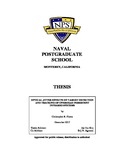| dc.description.abstract | The AA4871 Spacecraft Design course is the capstone class for the M.S. in Astronautics at the Naval Postgraduate
School. Thc design team integrated a Topaz If nuclear power system with an EOS Synthetic Aperture Radar to
design a low Earth orbit, three axis stabilized satellite flying in a gravity gradient stable orientation. The SAR is a high
resolution, electronically stecrable, Earth science data collector for glaciology, hydrology, vegetation,
occauography and geology which penetrates clouds, foliage and shallow soil layers. The antenna modulcs provide
global, regional, and local high resolution mapping. Tradeoffs were analyzed to optimize coverage, satisfy
nuclear safety issues, and to satisfy defined revisit and resolution requircmcnts. The design emphasized use of
qualified and readily available components and subsystems. The satellite features a cylindrical monocoquc alumiiium
structure, and a sun synchronous orbit simplifying thermal control design. It has a momentum bias attitude control
system with momentum wheels and thrusters. The antenna has microstrip radiating elements on a honeycomb metal and
composite structure and is articulated with respect to the spacecraft via an electric gimbal motor. Existing satcllitc
control and data processing and distribution facilitics and an existing launch vehicle and launch site limit cost and
tcchnical risk. The AA4871 Spacecraft Design course is the capstone class for the M.S. in Astronautics at the Naval Postgraduate
School. Thc design team integrated a Topaz If nuclear power system with an EOS Synthetic Aperture Radar to
design a low Earth orbit, three axis stabilized satellite flying in a gravity gradient stable orientation. The SAR is a high
resolution, electronically stecrable, Earth science data collector for glaciology, hydrology, vegetation,
occauography and geology which penetrates clouds, foliage and shallow soil layers. The antenna modulcs provide
global, regional, and local high resolution mapping. Tradeoffs were analyzed to optimize coverage, satisfy
nuclear safety issues, and to satisfy defined revisit and resolution requircmcnts. The design emphasized use of
qualified and readily available components and subsystems. The satellite features a cylindrical monocoquc alumiiium
structure, and a sun synchronous orbit simplifying thermal control design. It has a momentum bias attitude control
system with momentum wheels and thrusters. The antenna has microstrip radiating elements on a honeycomb metal and
composite structure and is articulated with respect to the spacecraft via an electric gimbal motor. Existing satcllitc
control and data processing and distribution facilitics and an existing launch vehicle and launch site limit cost and
tcchnical risk. The AA4871 Spacecraft Design course is the capstone class for the M.S. in Astronautics at the Naval Postgraduate
School. Thc design team integrated a Topaz If nuclear power system with an EOS Synthetic Aperture Radar to
design a low Earth orbit, three axis stabilized satellite flying in a gravity gradient stable orientation. The SAR is a high
resolution, electronically stecrable, Earth science data collector for glaciology, hydrology, vegetation,
occauography and geology which penetrates clouds, foliage and shallow soil layers. The antenna modulcs provide
global, regional, and local high resolution mapping. Tradeoffs were analyzed to optimize coverage, satisfy
nuclear safety issues, and to satisfy defined revisit and resolution requircmcnts. The design emphasized use of
qualified and readily available components and subsystems. The satellite features a cylindrical monocoquc alumiiium
structure, and a sun synchronous orbit simplifying thermal control design. It has a momentum bias attitude control
system with momentum wheels and thrusters. The antenna has microstrip radiating elements on a honeycomb metal and
composite structure and is articulated with respect to the spacecraft via an electric gimbal motor. Existing satcllitc
control and data processing and distribution facilitics and an existing launch vehicle and launch site limit cost and
tcchnical risk. The AA4871 Spacecraft Design course is the capstone class for the M.S. in Astronautics at the Naval Postgraduate
School. Thc design team integrated a Topaz If nuclear power system with an EOS Synthetic Aperture Radar to
design a low Earth orbit, three axis stabilized satellite flying in a gravity gradient stable orientation. The SAR is a high
resolution, electronically stecrable, Earth science data collector for glaciology, hydrology, vegetation,
occauography and geology which penetrates clouds, foliage and shallow soil layers. The antenna modules provide
global, regional, and local high resolution mapping. Tradeoffs were analyzed to optimize coverage, satisfy
nuclear safety issues, and to satisfy defined revisit and resolution requircmcnts. The design emphasized use of
qualified and readily available components and subsystems. The satellite features a cylindrical monocoquc alumiiium
structure, and a sun synchronous orbit simplifying thermal control design. It has a momentum bias attitude control
system with momentum wheels and thrusters. The antenna has microstrip radiating elements on a honeycomb metal and
composite structure and is articulated with respect to the spacecraft via an electric gimbal motor. Existing satcllitc
control and data processing and distribution facilitics and an existing launch vehicle and launch site limit cost and
tcchnical risk. The AA4871 Spacecraft Design course is the capstone class for the M.S. in Astronautics at the Naval Postgraduate
School. Thc design team integrated a Topaz If nuclear power system with an EOS Synthetic Aperture Radar to
design a low Earth orbit, three axis stabilized satellite flying in a gravity gradient stable orientation. The SAR is a high
resolution, electronically stecrable, Earth science data collector for glaciology, hydrology, vegetation,
occauography and geology which penetrates clouds, foliage and shallow soil layers. The antenna modulcs provide
global, regional, and local high resolution mapping. Tradeoffs were analyzed to optimize coverage, satisfy
nuclear safety issues, and to satisfy defined revisit and resolution requircmcnts. The design emphasized use of
qualified and readily available components and subsystems. The satellite features a cylindrical monocoquc alumiiium
structure, and a sun synchronous orbit simplifying thermal control design. It has a momentum bias attitude control
system with momentum wheels and thrusters. The antenna has microstrip radiating elements on a honeycomb metal and
composite structure and is articulated with respect to the spacecraft via an electric gimbal motor. Existing satcllitc
control and data processing and distribution facilitics and an existing launch vehicle and launch site limit cost and
tcchnical risk. The AA4871 Spacecraft Design course is the capstone class for the M.S. in Astronautics at the Naval Postgraduate
School. Thc design team integrated a Topaz If nuclear power system with an EOS Synthetic Aperture Radar to
design a low Earth orbit, three axis stabilized satellite flying in a gravity gradient stable orientation. The SAR is a high
resolution, electronically stecrable, Earth science data collector for glaciology, hydrology, vegetation,
occauography and geology which penetrates clouds, foliage and shallow soil layers. The antenna modulcs provide
global, regional, and local high resolution mapping. Tradeoffs were analyzed to optimize coverage, satisfy
nuclear safety issues, and to satisfy defined revisit and resolution requircmcnts. The design emphasized use of
qualified and readily available components and subsystems. The satellite features a cylindrical monocoquc alumiiium
structure, and a sun synchronous orbit simplifying thermal control design. It has a momentum bias attitude control
system with momentum wheels and thrusters. The antenna has microstrip radiating elements on a honeycomb metal and
composite structure and is articulated with respect to the spacecraft via an electric gimbal motor. Existing satcllitc
control and data processing and distribution facilitics and an existing launch vehicle and launch site limit cost and
tcchnical risk. | en_US |





